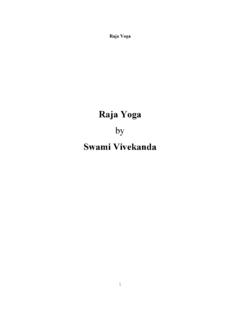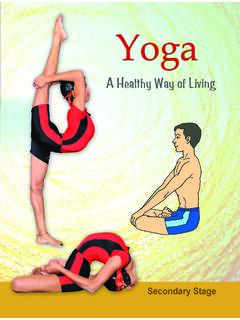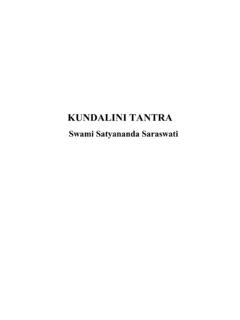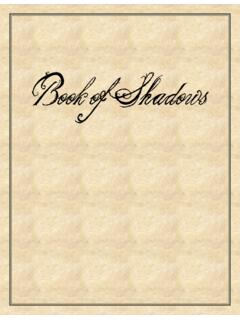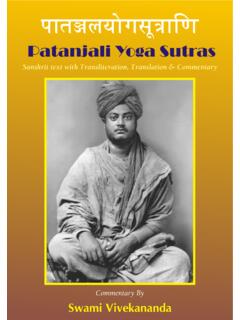Transcription of The Yoga Sutras of Patanjali
1 The yoga Sutras of Patanjali Introduction, Commentaries, and Translation What are the yoga Sutras and who is Patanjali ? Over fifty different English translations of the yoga Sutras are extant, standing as a human testament to how Universal Truth is celebrated in terms of a rich diversity. Rather than the common and external type of knowledge (emanating from book knowledge), the following translation and commentary are a result of an intimate familiarity and direct experience both with an authentic yogic tradition and with western culture, psychology, and language that has been refined, tested in fire, and integrated for over thirty five years of intense practice (sadhana). This work is dedicated toward revealing the universal message of authentic yoga that the sage, Patanjali , first wrote down approximately 2000 years ago. Patanjali is not the inventor of yoga , but rather yoga 's most popularly known scribe. What has become known simply as the " yoga Sutras " (sutra means thread) or almost equally as common, as the " yoga Darshana" (the vision of yoga ), is actually a compendium of an ancient pre-existing oral yoga tradition consisting of both practical advice and theoretical context.
2 The most accepted format of the yoga Sutras consists of four chapters (called padas) written in the Sanskrit language approximately 2000 years ago in Northern India while utilizing the terminology of the time, , Samkhya philosophical trappings. The dates ascribed to the yoga Sutras vary widely from 250 BC to 300 AD. 250 AD is very improbable based on comparative analysis with similar texts, grammar, and concurrent philosophical ideas of the era. This latter date is a conjecture based on the lack of any prior commentaries on the yoga Sutras before this date. What can be said is that Patanjali 's era was proto-tantric, Buddhist, Jain, Hindu, and eclectic. Because authentic yoga has been mainly an oral tradition (versus a written tradition), the practices of course precede the texts, but it is impossible to say how far ahead, because of the lack of prior literature. Today many people believe that yoga practices, spirituality, or even Ultimate Spirit (God) preceded from texts and man's beliefs, but we will deconstruct that as an absurd position.
3 From the life story of the Buddha (who was a yoga practitioner circa 500 BCE) and other accounts such yoga practices pre-existed perhaps prior than 1000 BC. A thorough historical analysis based on style, language, and literary techniques however can fairly accurately date Patanjali 's yoga Sutras , but such a discussion is beyond the scope of this presentation (see Accessing Patanjali for more on this subject). For our purpose we will accept the entire traditional four chapters of the " yoga Sutras " as being authentic (although acknowledging the controversy as to the possibility of additional Sutras being added post-humorously). Although classical Indian historians pay little detail to linear aspects of time, suffice it to say that the yoga Sutras were most likely penned somewhere around the time of Jesus, plus or minus 200 years. We will assume that Patanjali was an educated man who in his middle or latter life received oral instruction in raj yoga practices and took up the practices of yoga in the remote caves, forests, or river banks which were the most frequent practicing grounds of the time.
4 There Patanjali the yogi, gained the siddha (perfection) of nirbija samadhi (seedless samadhi), the crown achievement of yoga . As the remote havens of the yogis were receding and the true aspirants dwindling, it is thought that Patanjali decided to record the most essential yoga teachings which was his guide and inspiration to enlightenment. As a system, the type of yoga as put forth by Patanjali , is non-theistic, having not even the slightest suggestion of worshipping idols, deities, gurus, or sacred books; but at the same time it does not contain any atheistic doctrine either. Although this fact has been contested by self interested groups, a careful unbiased study of the yoga Sutras , especially the discussion of what Patanjali means by the word, "isvara", will prove the aforesaid fact as incontestable. Meditation (dhyana), Practice (abhyasa), and Vairagya (non-grasping) are the Keys Within the broad category of what is called yoga , the yoga Sutras most properly belong to the school of Raj (Royal) yoga , which succinctly can be defined as yoga practices which are culminated in meditation (dhyana) leading to samadhi.
5 A careful reading of the yoga Sutras will reveal to the astute meditator, an elucidation of the hindrances to meditation (in the forms of kleshas, samskara, vasana, vrtti, and karma which in turn are caused by avidya or ignorance) as well as their remediation through the various effective processes of liberation (mukti) that occur and/or are available through the main remedy of meditation and its auxiliary practices such as the practices found in ashtanga (eight limbed) yoga , kriya yoga , etc. Thus it is safe to say that the yoga Sutra is an excellent companion for those who would use meditation as a path. Here one may use the yoga Sutras as a lab book . Read a little, then practice, read some more, practice, read, and so forth in that way. The lab book enhances the practice. Here it is the practice which reveals. It is our experience which educates our beliefs. Our beliefs must conform to "reality", not the other way around.
6 Such then are mutual synergists. Patanjali warns against domination of the vrtti of preconceived beliefs (no matter how authoritative), and tells us to be present in our experience. Although meditation (raj yoga ) is the main practice, other adjunctive practices also are offered including a number of proto-tantric elements can be found in the yoga Sutras (the latter especially in chapter three, Vibhuti Pada (mainly dharanas utilizing samyama). As such the yoga Sutras can be read as a lab book to successful meditation (dhyana) and samadhi (absorption). Without a doubt the yoga Sutras can not be understood by a non-meditator. Practice is the key -- pause for practice and more practice. The yoga Sutra, is not a philosophy book to be studied with the intellect or ordinary mind, but rather it is an experiential workbook that is revealed by an open heart. Wisdom is by its nature, trans-rational and transconceptual -- broader than any manmade conception or constructed thought wave, and Patanjali everywhere confirms that hypothesis.)
7 Wisdom as well as intellect comes from an innate sourceless intelligence of the universal boundless mind. That is the light behind consciousness -- param purusha. Patanjali tells us that at the end of ordinary linear thought processes is where meditation begins; while the end of meditation itself is samadhi (total integration). This is the practice of yoga (integration) where yoga is the verb, practice, and process; while nirbij (seedless) samadhi in kaivalyam (absolute freedom) realizing our true natural unconditioned Self (swarupa) as purusa-sattva is the objectless ever present goal. Success in yoga is through practice. It is not reached by reading about it, dissecting a book , nor discussing it. The practice of yoga (called sadhana) through meditation (dhyana) brings the practitioner (sadhak) far more aligned and connected than what is capable via the ordinary mental machinations classified as vrttis (such as conceptional thought, philosophical speculation, the study of semantics, grammar, memorization of rules or fact, ceremony, prayer, and so forth).
8 Indeed, Patanjali says that when yoga is accomplished through the cessation of the vrttis, then one abides in swarupa, a recognition/revelation of our self existing uncontrived true nature -- the unconditioned and sacred natural self. Prabhava is thus associated with pravrtti, while swabhava is associated with swarupa. These terms will be explained in the text proper. Thus Patanjali repeatedly warns against the futility of approaching meditation via the intellect, but rather to attain the wisdom which lies beyond through abandoning conceptional frameworks. The first signs of success in the experience of meditation is the removal of such limitations by directly realizing them as hindrances. Thus the Sutras can be understood more deeply only after one has practiced some meditation, allowing one to reflect upon the Sutras from the context of one's own direct meditative experience. Then one can reflect on the Sutras utilizing the deeper presence and living wisdom of the unbiased heart; and as such then true and lasting benefit will accrue.
9 The point is not to study the yoga Sutras as an end in itself (the goal of philosophy or academia) or as an external object that can be clenched, but to use the Sutras as a synergistic aid to the practices, which when combined in a balanced manner evokes wisdom and liberation (primarily via a functional meditation practice) which manifests in our daily lives. What the yoga Sutras are Not Making the " yoga Sutras " accessible to the burgeoning numbers of Western students of yoga , a new readable translation rooted true to the context of yoga itself (versus traditional religious orthodoxy) has long been needed. Even well intended Swamis and yoga practitioners have made the same error , of dispositioning orthodox authority into the text, rather than recognizing that Patanjali is pointing to our own practice (sadhana) in one's own yogic experience as the instructor, not books, religious paraphernalia, ceremony, ritual, puja, priests, books, or gurus.
10 Thus both the focus and context too often has become co-opted, colored, and/or perverted. The yoga Sutras rather, in order to be taken to heart, have to be read in context of one's own meditation experience. There exists no other adequate way to evaluate it, because the vary context which it tries to elucidate lies outside of the individual intellect, conceptual reality, duality of any separate self -- of any disconnection from anything else itself, from labeling, categorizing, or the process of identification itself. This of course sounds strange to some one who is intellectually bent, but through meditation one understands this with an absolute certainty. The Sutras exist for one purpose, to help the meditator (the sadhak) in their spiritual journey of re-connection ( yoga ). Understanding and learning the yoga Sutras in and by itself can be a vain intellectual diversion/distraction, while the real work is in understanding the Authentic Self which resides in All -- which shines forth through the fog covering of ignorance (avidya) from the eyes of the accomplished sadhak (siddha).
